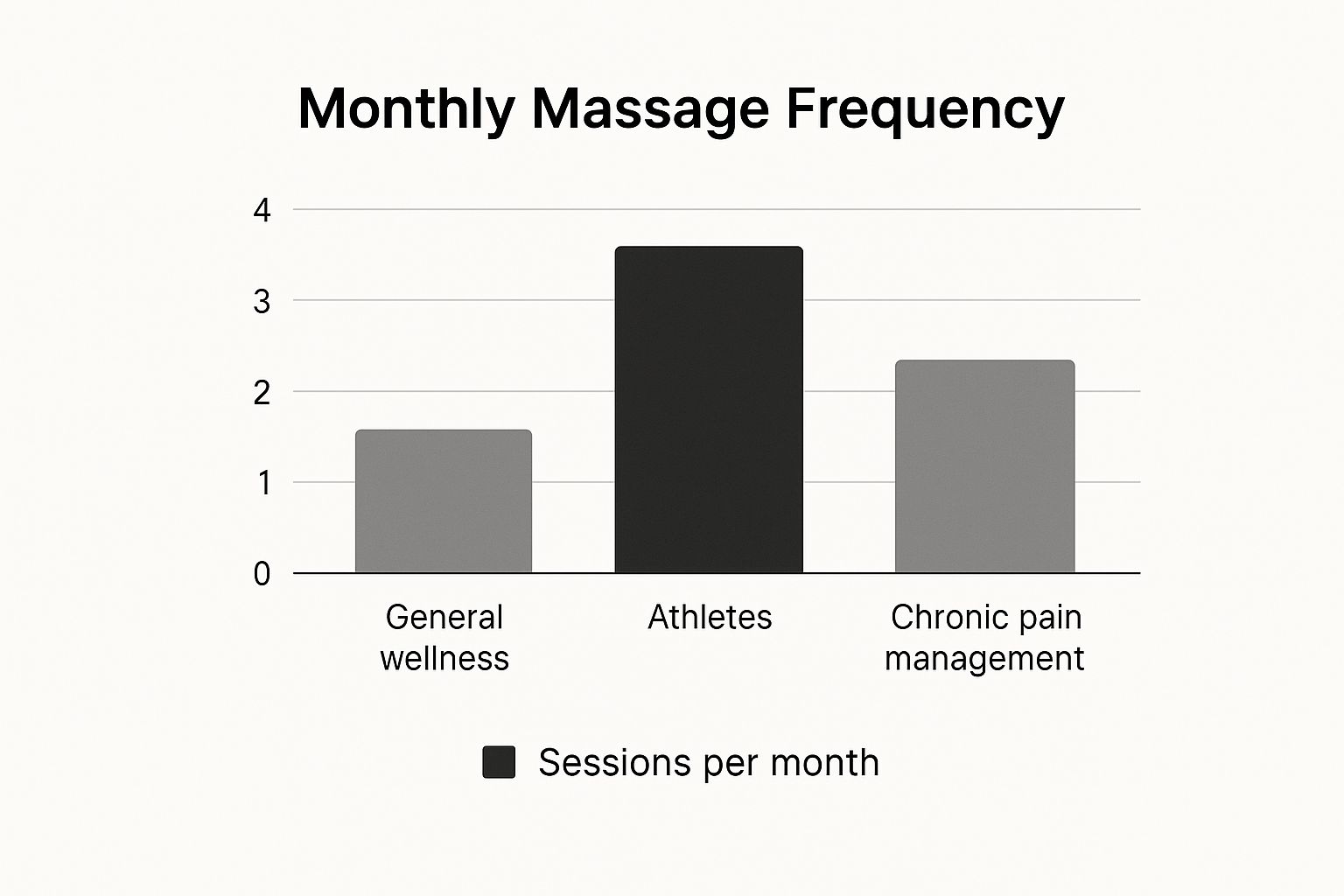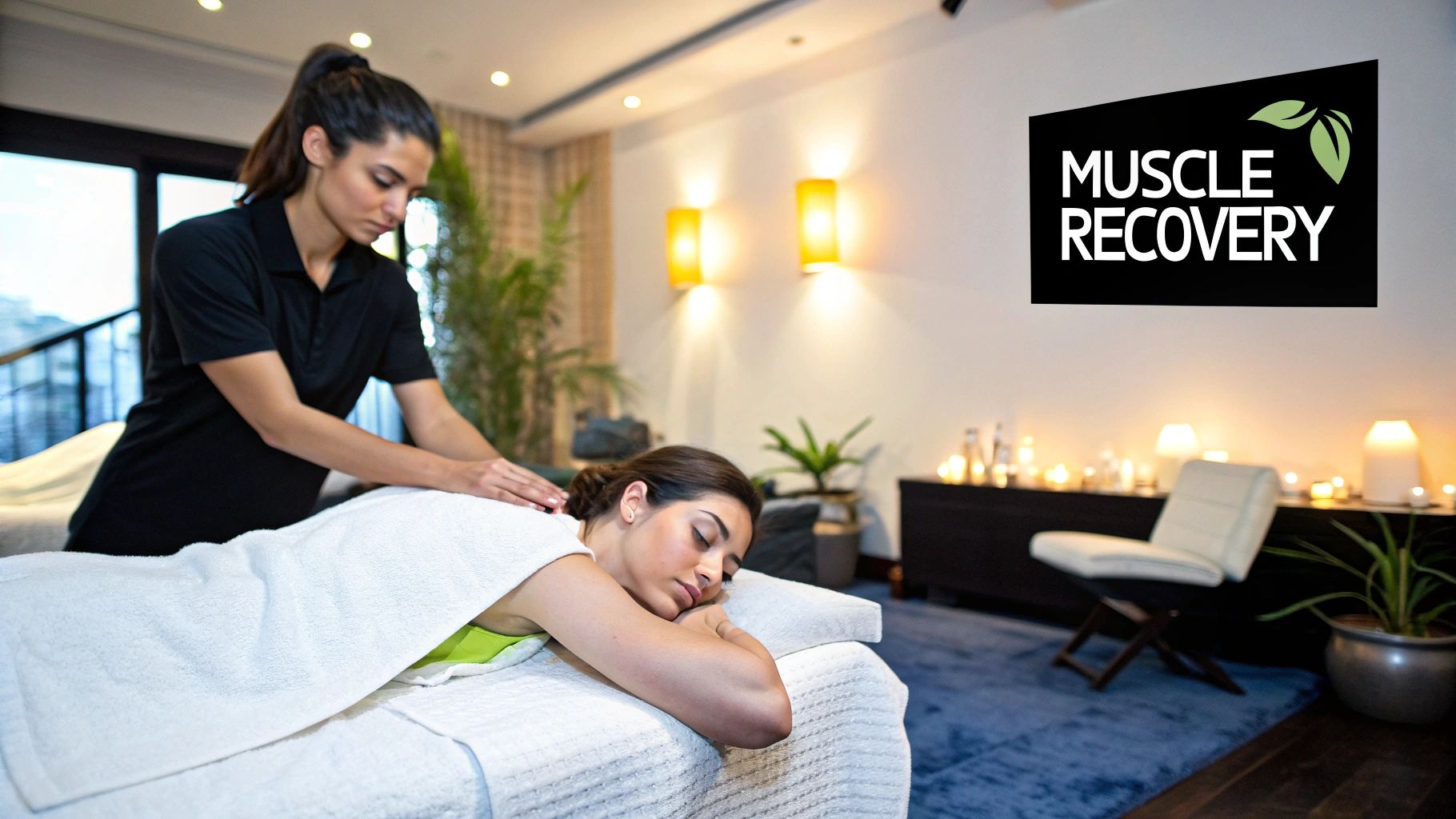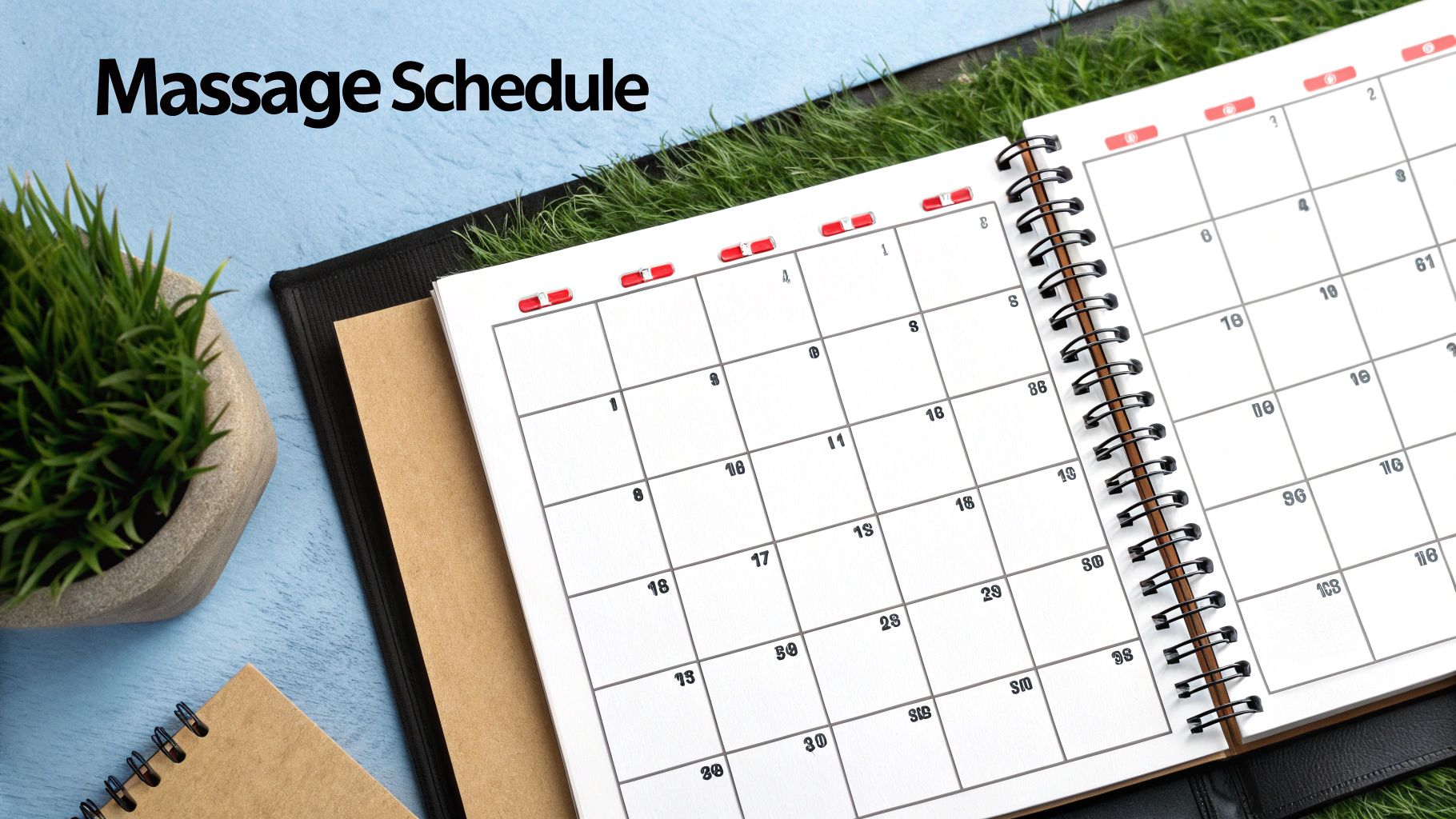How Often Should I Get a Massage? Find the Perfect Frequency

So, how often should you really be getting a massage? While there's no single magic number, a great rule of thumb for general wellness is about once or twice a month. But if you're tackling something more specific, like recovering from a tough workout or managing chronic pain, you might need to book appointments more often—think weekly or every other week.
The real key, no matter your goal, is consistency. That’s how you unlock the long-term benefits.
Finding Your Perfect Massage Rhythm
Figuring out the right massage schedule is a lot like creating a custom workout plan. It's deeply personal and depends entirely on what you're hoping to achieve, your lifestyle, and how your body feels. There’s no universal answer, but looking at common scenarios can give you a fantastic starting point.
This chart breaks down the average monthly massage frequencies people get based on their goals.

As you can see, your "why" directly shapes the "how often." Athletes, for example, need more frequent sessions to stay in peak condition, while someone focused on relaxation might only need a monthly tune-up.
To give you a clearer picture, I've put together a quick-glance table. It summarizes the most common goals and the frequency that usually works best for each.
| Recommended Massage Frequency Based on Your Goal |
| :— | :— | :— |
| Your Primary Goal | Recommended Frequency | Best For |
| General Wellness & Stress Relief | 1-2 times per month | Maintaining balance, managing everyday tension, and proactive self-care. |
| Chronic Pain Management | 1-4 times per month | Addressing persistent issues like back pain or sciatica. More frequent initially. |
| Athletic Performance & Recovery | 2-4 times per month | Enhancing muscle recovery, improving flexibility, and preventing injuries. |
| Injury Rehabilitation | 4+ times per month (initially) | Working with a therapist as part of a targeted recovery plan from a specific injury. |
| Pregnancy (Prenatal Massage) | 1-2 times per month | Easing discomfort associated with pregnancy, like back pain and swelling. |
This table is just a guide, of course. The best approach is always to listen to your body and work with your massage therapist to adjust the plan as you go.
Start With Your Primary Goal
The first and most important question to ask yourself is: Why do I want a massage? Are you trying to escape the stress of a demanding job, or are you trying to manage a physical issue that just won't go away?
-
For General Stress Relief and Wellness: Think of a monthly massage as your personal "reset button." It's a fantastic way to keep everyday stress in check and maintain a baseline of feeling good in your own skin.
-
For Athletic Performance and Recovery: If you're active in sports or hit the gym regularly, a more frequent schedule is your best bet. Getting a massage once a week or every other week can help your muscles recover faster, prevent nagging injuries, and keep you flexible.
-
For Chronic Pain or Specific Conditions: If you're dealing with something persistent like chronic back pain, fibromyalgia, or sciatica, you'll likely need weekly sessions, at least at the beginning. This helps break the pain cycle and get your symptoms under control.
The goal isn't just about feeling better for an hour. It's about creating cumulative benefits. Each massage builds on the last, leading to more profound and lasting improvements in muscle health, flexibility, and your ability to handle stress.
This mindset is becoming more common. People are increasingly seeing massage as a crucial part of their health routine, not just a luxury. In fact, a whopping 61% of consumers get massages specifically for medical or health reasons. It's a clear signal that we're moving toward a more holistic view of healthcare, and you can learn more about the growth of massage therapy services in recent industry reports.
Matching Your Massage Schedule to Your Lifestyle

The perfect massage schedule isn’t something you’ll find on a generic chart. It’s something you discover by looking at your own life, because a one-size-fits-all approach just doesn't cut it when everyone’s daily grind is so different. Think of yourself as a detective, piecing together clues from your own routine to find what works for you.
It's a bit like watering a plant. You wouldn't give a hardy cactus the same amount of water as a thirsty fern basking in the sun, right? Your body is no different. Its need for massage therapy rises and falls based on the physical and mental demands you place on it day in and day out.
To really nail down your ideal frequency, you’ve got to get honest about your activity levels, the stress of your job, and what triggers your tension. This self-awareness is the first and most important step toward creating a routine that gives you real, lasting relief.
The Desk Worker and “Tech Neck”
If you spend 8 hours a day glued to a desk, your body is fighting a very specific battle. That constant forward-leaning posture, staring at a screen, is the perfect recipe for what many now call "tech neck"—that nagging combination of tight shoulders, a stiff neck, and a persistent ache in the upper back.
For desk workers, the tension is cumulative. It sneaks up on you, building quietly from Monday to Friday, until you can really feel it by the end of the week.
A massage every 2 to 4 weeks is your secret weapon. It acts as a powerful reset button, counteracting the gradual shortening of your chest muscles and the constant strain on your back. This helps restore your natural posture and stops chronic pain patterns from taking hold.
Think of it as undoing the postural damage before it becomes a much bigger problem, keeping you comfortable and focused at your desk.
The Physically Demanding Job
Now, let's flip the script and think about someone whose job is all about physical effort. Maybe you're a construction worker, a nurse who is constantly on the move, or a warehouse employee lifting and carrying all day. In these roles, muscle fatigue isn't just a possibility; it's a daily reality. The goal here shifts from simple relaxation to active recovery and preventing injuries.
For this kind of work, a more frequent massage schedule is often what’s needed to keep your body from breaking down.
- Weekly Sessions: This is a fantastic idea during especially tough work weeks or for anyone who deals with constant muscle soreness. A weekly massage helps flush out metabolic byproducts and reduce inflammation.
- Bi-Weekly Sessions: This works as a solid maintenance plan to manage the ongoing physical stress. It allows for regular deep tissue work to break up knots and adhesions before they start messing with your mobility.
For people in physically demanding jobs, a massage isn't an indulgence. It's essential maintenance, just like getting an oil change for a car you rely on every single day.
The Weekend Warrior or Dedicated Athlete
Are you a gym enthusiast whose legs are screaming after a tough workout? Or maybe you're a "weekend warrior," packing a whole week’s worth of running, hiking, or sports into two days? If so, your massage needs are tied directly to your training schedule.
When you're in the middle of intense training or gearing up for a competition, a weekly sports massage can be a game-changer. It can seriously boost your performance and slash your recovery time. These sessions are targeted, focusing on the specific muscles you're pushing to the limit to improve flexibility and fix minor strains before they sideline you with an injury.
During your off-season or when your activity level is lighter, you can ease up a bit, maybe scaling back to a bi-weekly or monthly massage to maintain muscle health. The key is to listen to your body. If you're feeling extra sore or your recovery is dragging, that's your cue to get back on the table.
Using Massage for Chronic Pain and Health Conditions

When you're dealing with a chronic condition like fibromyalgia, sciatica, or arthritis, massage therapy shifts from a "nice-to-have" luxury to an essential part of your management plan. The question of how often you should get a massage becomes less about general wellness and more about targeted, therapeutic care. The goal here isn’t just relaxation; it's about getting your quality of life back.
Think of chronic pain like a stubborn, smoldering fire. A single massage might pour some water on it and cool things down for a bit, but consistent sessions are what truly reduce the heat and keep it from flaring up again. Regular massage helps soothe a nervous system that's often stuck in high alert from chronic pain, and it boosts circulation to bring vital oxygen and nutrients to sore, inflamed tissues.
Breaking the Pain Cycle
With many chronic conditions, the first and most important step is to break the relentless pain cycle. This usually means starting with a more intensive schedule to really get a handle on your symptoms and make a noticeable impact.
-
Initial Phase (Breaking the Cycle): It’s very common to begin with weekly massages. This frequency helps interrupt the constant pain signals and gives your muscles a genuine chance to let go of deeply held tension. For instance, someone with acute sciatica might need weekly sessions to relieve pressure on the nerve and calm the inflammation.
-
Maintenance Phase (Managing Symptoms): Once you start to feel a real difference and your pain is more manageable, you can usually scale back to a maintenance schedule. This could mean getting a massage every two to three weeks. This rhythm is all about sustaining your progress and stopping the pain from creeping back to its old intensity.
The real secret is to see massage as a cumulative therapy. Each session builds on the last, gradually retraining your body's muscles and nervous system. It’s not about a single magic fix, but about establishing a new, more comfortable normal for your body.
Creating a Safe and Effective Plan
While working with a licensed massage therapist is vital, teaming up with your primary doctor or specialist is just as critical. A knowledgeable therapist will understand which techniques are safe and effective for your specific condition and, just as importantly, which ones to avoid. For example, deep tissue work might be too much during a fibromyalgia flare-up, whereas a gentler approach could bring incredible relief.
This is where a therapeutic massage really shines. It's an approach focused entirely on achieving specific health goals, whether that’s reducing pain or improving your range of motion. If you're wondering how this is different from a standard relaxation massage, our guide explains in detail what therapeutic massage is and how it can be customized just for you.
The growing trust in massage as a legitimate health tool is undeniable. In the U.S. alone, there are over 321,000 registered massage therapists, and it's estimated they delivered 150 million sessions in 2023. These numbers show just how many people are turning to massage for both physical and mental well-being.
Understanding complementary techniques can also be incredibly helpful. Learning about the role of lymphatic drainage in skin health, for example, provides insight into how different modalities can support the body’s innate healing systems. Ultimately, finding the right massage frequency is about creating a personalized plan—a collaboration between you, your therapist, and your doctor—to help you live more comfortably.
Finding Your Rhythm: Massage for Stress and Mental Health
https://www.youtube.com/embed/SxroabUx1Xs
Think of your stress levels like a bucket. Every single day, little things—work deadlines, family duties, the constant ping of your phone—add more water. If you don't find a way to empty it, that bucket is going to overflow. When it does, you're left feeling swamped, anxious, and just plain drained. Regular massage is one of the best ways to keep that bucket from spilling over.
There's real science behind the connection between touch and mental clarity. A good massage helps dial down your body's "fight or flight" response by lowering levels of the stress hormone, cortisol. As cortisol decreases, your body gets the signal to ramp up production of feel-good chemicals like serotonin and dopamine. The result is a profound sense of calm that sticks with you long after the session ends.
Proactive Care vs. Crisis Management
So, what’s the magic number for mental health massages? It really depends on whether you're playing defense against everyday stress or offense during a particularly tough time.
For general, proactive mental wellness, a monthly massage is a fantastic starting point. This cadence works like preventative maintenance for your mind, consistently keeping your stress levels in check. It helps you maintain a sense of balance, making you far more resilient when life throws you a curveball.
But what about those times when life is just a lot? Maybe you're facing a huge project at work, dealing with a family crisis, or going through a major life transition. During these high-stakes periods, your needs change. Upping your sessions to weekly or bi-weekly can be a lifeline. It provides immediate relief and helps stop stress from spiraling into something more serious, like burnout or chronic anxiety.
Think of it this way: A monthly massage is your routine mental health tune-up, keeping everything running smoothly. A weekly session during a rough patch is like calling in the cavalry—it gives your mind and body the extra support they desperately need to weather the storm.
Getting the Most Out of Your Sessions
The type of massage you choose makes a difference, too. While a classic, gentle Swedish massage is wonderful for overall relaxation, don't be afraid to ask for more focused work if you need it. Stress has a funny way of showing up physically as tight shoulders, a stiff neck, or tension headaches, all of which just add to your mental load.
Sometimes, the fastest way to mental peace is by tackling that physical tension head-on. Understanding the benefits of deep tissue massage can help you figure out if you need a more targeted approach to release those stubborn knots that are fueling your stress. When you treat the physical symptoms, the mental relief often follows.
Ultimately, the goal is to shift your mindset. Massage isn't just a treat for when you're already stressed out; it's a powerful, proactive tool for building a more resilient and centered mind. By finding a schedule that fits your life, you can make massage a core part of your mental health strategy.
How to Adjust Your Massage Schedule Over Time

Your body isn't a static machine that runs on a fixed maintenance schedule. It's a living, breathing system that’s always changing. The massage frequency that worked wonders for you six months ago might not be the right fit today.
This is why a truly effective wellness plan treats massage frequency as a flexible tool, not a rigid rule. You can—and should—adapt your schedule based on what your body is telling you right now.
Thinking this way puts you in the driver’s seat. You’re empowered to make smart adjustments that keep your sessions effective and perfectly tuned to your current needs. Honestly, learning to listen to your body is the most important skill you can develop in your wellness journey.
Reading Your Body’s Signals
Your body is constantly sending you messages—some subtle, others not so much. Recognizing these cues is the secret to knowing when it’s time to book your next appointment or maybe even push it back a bit.
Here are a few tell-tale signs that you might need to schedule a massage sooner rather than later:
- Recurring Tension: Is that old knot in your shoulder making a comeback faster than usual?
- Trouble Sleeping: If you're tossing and turning more, it's often a sign that physical tension or stress is getting in the way of a good night's rest.
- Increased Workout Intensity: Have you ramped up your fitness routine or started training for an event? Lingering muscle soreness is a clear signal your body needs more recovery support.
- Frequent Headaches: A sudden spike in tension headaches often points directly to overworked muscles in your neck and shoulders that are crying out for relief.
On the flip side, if you're feeling fantastic, bouncing back from workouts with ease, and those old aches are a distant memory, you might have some room to space your sessions out a little more.
Think of your massage therapist as your co-pilot. They have the expertise to help you interpret your body’s signals and adjust your flight plan accordingly. An open, honest conversation about how you’re feeling is one of the most valuable parts of your therapy.
Having Productive Conversations with Your Therapist
To get the most out of every single session, regular check-ins with your therapist are absolutely essential. Don't be shy about starting the conversation; they genuinely want to know what’s working and what isn’t.
Here’s a simple way to frame the discussion at the start of your appointment:
- Share Your Progress: Tell them how you felt after the last session. Did the relief last for three days or three weeks? Be specific.
- Discuss New Developments: Let them know about any changes in your life. Have you started a new desk job, been under a lot more stress, or picked up a new physical hobby?
- Talk About Your Goals: Revisit why you started getting massages in the first place. Are you still focused on the same goal, or has a new one cropped up?
This kind of teamwork turns your massage from a passive treatment into a true health partnership. It ensures your plan is always targeted and responsive, giving you the right answer to "how often should I get a massage?" for whatever life throws your way.
Of course. Here is the rewritten section, crafted to sound completely human-written and natural.
Making Regular Massages an Affordable Part of Your Life
Let's be real for a moment: the cost is often the biggest roadblock when it comes to getting massages regularly. You know consistent bodywork is what your body needs, but shelling out for a premium session every week or two can feel like a pipe dream. The good news? It doesn't have to be. With a bit of savvy planning, you can absolutely make regular massage a sustainable part of your life.
The trick is to think beyond the sticker shock of a single, drop-in appointment. There are plenty of fantastic, high-quality options out there that won't break the bank.
Find Smart Savings Opportunities
One of the best-kept secrets in the wellness world is the student clinic. Reputable massage schools have clinics where advanced students provide massages at a huge discount to get their required practice hours. Don't worry, they're always supervised by seasoned instructors. It’s a win-win: you get excellent, affordable bodywork, and you help a future therapist hone their craft.
Another great strategy is to scout out membership programs or package deals at your local massage studios and spas.
Buying sessions in a bundle or signing up for a monthly plan almost always drops the per-session price. This simple shift in thinking turns massage from an occasional, guilt-ridden splurge into a predictable, manageable line item in your wellness budget.
Finally, don't forget to check your benefits. You might be surprised to learn that your health insurance could cover massage therapy if a doctor prescribes it for a specific medical issue. Many people can also use pre-tax dollars from a Flexible Spending Account (FSA) or Health Savings Account (HSA) to pay for therapeutic massages.
When you start exploring these avenues, the entire financial picture can change. Suddenly, regular massage stops feeling like an out-of-reach luxury and starts looking like the essential, affordable self-care it truly is.
Common Questions About Finding Your Massage Rhythm
Even with the best advice, you probably still have a few questions floating around. Let's tackle some of the most common ones so you can feel completely confident in your massage schedule.
Does the Type of Massage Change How Often I Should Get One?
Absolutely. Think of it like a workout. An intense deep tissue or sports massage is a serious workout for your muscles, so giving them a couple of weeks or even a full month to recover is smart.
On the other hand, a gentler Swedish massage is more like a brisk walk. It’s much less demanding, so you could easily enjoy one every week without overdoing it.
What Happens If I Miss an Appointment?
Life happens! Don't sweat it. The real magic of massage comes from consistency over the long haul, not from a perfect attendance record.
If you miss a session, just hop back into your routine as soon as you can. You might feel some of that old tension creeping back, which is just a little reminder of how much your body loves those regular treatments.
Is It Possible to Get Too Much Massage?
It’s not common, but yes, you can overdo it, especially with more intensive bodywork. The biggest signs are feeling constantly sore, bruised, or tender to the touch long after your session.
This is your body's way of saying it needs more downtime to heal. As you figure out your ideal frequency, learning about different techniques, like the ones in our guide to pain relief massage therapy, can make a big difference. The number one rule is always to listen to what your body is telling you and keep an open line of communication with your therapist.
Ready to build a massage plan that truly works for you? The experienced therapists at La Moon Massage and Facial are masters at helping you find the perfect rhythm for wellness. Discover how our premium treatments can soothe your body and mind by booking your next session at https://www.lamoondayspa.com.
